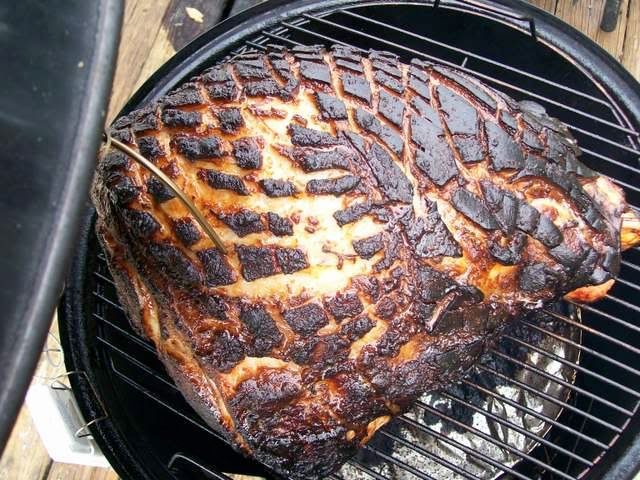Dan H.
TVWBB Pro
i'll try to keep it short guys but may end up long. my buddy called again and IS really having some hogs butchered soon, and is really bringing it to me to smoke. quick reading on tvwb has put together this plan for me and i'd REALLY appreciate some help and advice, do's and don'ts, and if you had it to do over again what you would do different, and make sure i didn't mis-understand etc. thanks.
plan is:
i'll recieve the ham, could be entire portion (shank+butt) or maybe not, unsure of that (unfortunatly, i'll find out tomarrow)
I'de like it to be pretty 'normal'tasting cause its what he would kind of expect it sounds like, so I'd appreciate a recommended brining recipie, (assume anything you would find in stores would be GREAT, like "honey curred" etc., nothin crazy like applications of beef blood or anything
 ) Looks to me like i'll need a brine of about 2 weeks from reading, correct? (or maybe it depends on ingredients, not sure. but i do not have easy access to a injector right now either just so you know)
) Looks to me like i'll need a brine of about 2 weeks from reading, correct? (or maybe it depends on ingredients, not sure. but i do not have easy access to a injector right now either just so you know)
after a brine, does it need some air out time? if yes, then fine, if no, i'll proceed to smoke/cook on wsm at Chris A's recommened temp of 300somethin' (forgot now, but will look again, its in the 'ham' section of cooking topics) Now next important question is:
Is there any way to partially cook this for him w/ the smoke flavor included etc. so he could choose to cook FULLY whenever convienient for him? (much like us buying one at a store partially cooked/smoked) Or would you say to cook fully, safeley cool/refrige somehow (there large cuts, and I wanted to leave it whole for him...???) then deliver for a proper reheat (by him) later? and will a fully cooked product reheat well without hurting the taste and texture or quality? ( i assume it would be fine for the storboughts do fine reheated, then again there cooking process may differ,) this is slightley stressfull for i've never done it and originally assumed he must have changed his mind or got busy. but no, He said he could have it to me this weekend if I wanted to smoke/cook it for him. cant tell you how thankfull I am for the help.
plan is:
i'll recieve the ham, could be entire portion (shank+butt) or maybe not, unsure of that (unfortunatly, i'll find out tomarrow)
I'de like it to be pretty 'normal'tasting cause its what he would kind of expect it sounds like, so I'd appreciate a recommended brining recipie, (assume anything you would find in stores would be GREAT, like "honey curred" etc., nothin crazy like applications of beef blood or anything
after a brine, does it need some air out time? if yes, then fine, if no, i'll proceed to smoke/cook on wsm at Chris A's recommened temp of 300somethin' (forgot now, but will look again, its in the 'ham' section of cooking topics) Now next important question is:
Is there any way to partially cook this for him w/ the smoke flavor included etc. so he could choose to cook FULLY whenever convienient for him? (much like us buying one at a store partially cooked/smoked) Or would you say to cook fully, safeley cool/refrige somehow (there large cuts, and I wanted to leave it whole for him...???) then deliver for a proper reheat (by him) later? and will a fully cooked product reheat well without hurting the taste and texture or quality? ( i assume it would be fine for the storboughts do fine reheated, then again there cooking process may differ,) this is slightley stressfull for i've never done it and originally assumed he must have changed his mind or got busy. but no, He said he could have it to me this weekend if I wanted to smoke/cook it for him. cant tell you how thankfull I am for the help.

